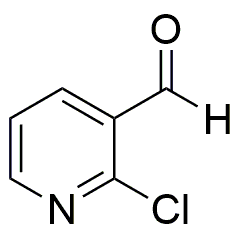2-Chloro-3-pyridinecarboxaldehyde is widely utilized in research focused on:
- Synthesis of Pharmaceuticals: This compound serves as a key intermediate in the synthesis of various pharmaceutical agents, particularly those targeting neurological disorders. Its unique structure allows for the development of novel drug candidates.
- Agricultural Chemicals: It is used in the formulation of agrochemicals, including herbicides and fungicides, enhancing crop protection and yield. This application is crucial for sustainable agriculture practices.
- Organic Synthesis: Researchers employ it in organic synthesis reactions, such as the preparation of heterocyclic compounds. Its reactivity and functional groups make it a valuable building block in organic chemistry.
- Material Science: The compound is explored in the development of advanced materials, including polymers and coatings, due to its ability to modify surface properties and improve durability.
- Analytical Chemistry: It is utilized as a reagent in analytical methods, such as chromatography, helping to identify and quantify other chemical substances effectively.
General Information
Properties
Safety and Regulations
Applications
2-Chloro-3-pyridinecarboxaldehyde is widely utilized in research focused on:
- Synthesis of Pharmaceuticals: This compound serves as a key intermediate in the synthesis of various pharmaceutical agents, particularly those targeting neurological disorders. Its unique structure allows for the development of novel drug candidates.
- Agricultural Chemicals: It is used in the formulation of agrochemicals, including herbicides and fungicides, enhancing crop protection and yield. This application is crucial for sustainable agriculture practices.
- Organic Synthesis: Researchers employ it in organic synthesis reactions, such as the preparation of heterocyclic compounds. Its reactivity and functional groups make it a valuable building block in organic chemistry.
- Material Science: The compound is explored in the development of advanced materials, including polymers and coatings, due to its ability to modify surface properties and improve durability.
- Analytical Chemistry: It is utilized as a reagent in analytical methods, such as chromatography, helping to identify and quantify other chemical substances effectively.
Documents
Safety Data Sheets (SDS)
The SDS provides comprehensive safety information on handling, storage, and disposal of the product.
Product Specification (PS)
The PS provides a comprehensive breakdown of the product’s properties, including chemical composition, physical state, purity, and storage requirements. It also details acceptable quality ranges and the product's intended applications.
Certificates of Analysis (COA)
Search for Certificates of Analysis (COA) by entering the products Lot Number. Lot and Batch Numbers can be found on a product’s label following the words ‘Lot’ or ‘Batch’.
*Catalog Number
*Lot Number
Certificates Of Origin (COO)
This COO confirms the country where the product was manufactured, and also details the materials and components used in it and whether it is derived from natural, synthetic, or other specific sources. This certificate may be required for customs, trade, and regulatory compliance.
*Catalog Number
*Lot Number
Safety Data Sheets (SDS)
The SDS provides comprehensive safety information on handling, storage, and disposal of the product.
DownloadProduct Specification (PS)
The PS provides a comprehensive breakdown of the product’s properties, including chemical composition, physical state, purity, and storage requirements. It also details acceptable quality ranges and the product's intended applications.
DownloadCertificates of Analysis (COA)
Search for Certificates of Analysis (COA) by entering the products Lot Number. Lot and Batch Numbers can be found on a product’s label following the words ‘Lot’ or ‘Batch’.
*Catalog Number
*Lot Number
Certificates Of Origin (COO)
This COO confirms the country where the product was manufactured, and also details the materials and components used in it and whether it is derived from natural, synthetic, or other specific sources. This certificate may be required for customs, trade, and regulatory compliance.


